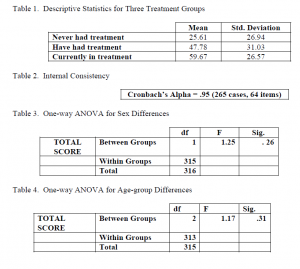Paul M. Rose and Dr. M. Gawain Wells, Psychology
Introduction
In the wake of increasing interest and demand from mental health care providers for sophisticated youth outcome measures, Burlingame, Wells and Lambert constructed the Youth Outcome Questionnaire (YOQ) in 1996 (1). To fill the need for an adolescent self-report version of the YOQ, Burlingame, Wells, and Lambert later developed the adolescent self-report version of the YOQ (YOQ2SR) (2). Before the YOQ2SR can be used in mental health practice, normative data must be collected from adolescents who are not in treatment. The present study provided this data.
Method
To generate normative data for this new measure, 307 adolescents from a junior high school and two high schools completed the YOQ2SR. Each student received a candy bar for her/his participation and $1 was contributed to the students’ schools for each useable questionnaire returned.
Results
Means and standard deviations for respondents in three different treatment categories are reported below. The data are also statistically analyzed using Cronbach’s Alpha for internal consistency (a measure of test reliability). We also performed one-way analyses of variance for gender and age differences, and analyzed interactions between gender and age. Ages were consolidated into age groups by twos, such that 13- and 14-year olds composed one group, 15- and 16-year-olds composed another, etc. All data are summarized in tables 1, 2, 3, and 4.
Discussion
Statistical tests suggest that the YOQ2SR is a remarkably internally consistent measure. Like the YOQ, this instrument manifests no significant differences between sex or age groups. Future analyses with additional data should continue to reveal significant differences between adolescents who have never had treatment, adolescents who have had treatment, and those that are currently in treatment groups. Such data will allow us to determine appropriate cut-off scores between groups. Data from the present study will play a crucial role in the YOQ2SR administrative manual that we will produce later this year (3).
References
1. Burlingame, G. M., Wells, M. G. & Lambert, M. J. (1996). The Youth Outcome Questionnaire–Self-Report Version. American Credentialing Services: Stevenson, MD.
2. Burlingame, G. M., Wells, M. G. & Lambert, M. J. (1996). The Youth Outcome Questionnaire. American Professional Credentialing Services: Stevenson, MD.
3. We thank Katherine Rose for her assistance in data collection and entry.
Statistical Tables

